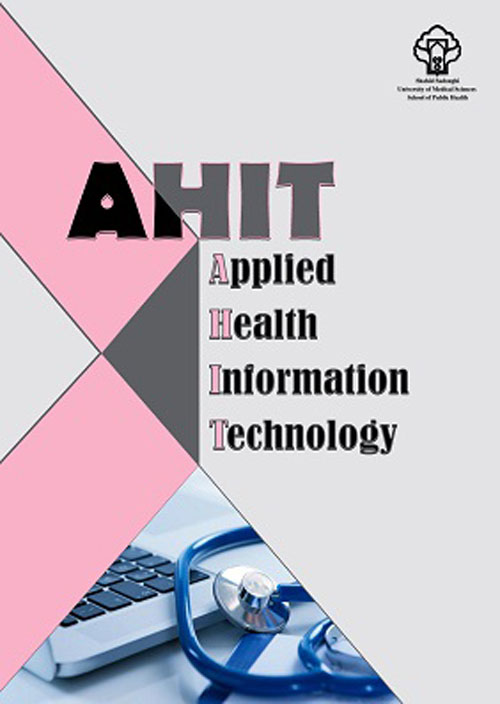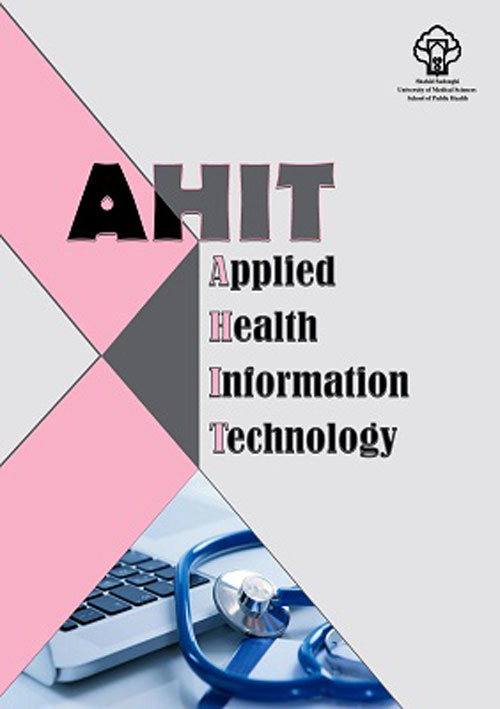فهرست مطالب

Applied Health Information Technology
Volume:1 Issue: 1, Winter-Spring 2020
- تاریخ انتشار: 1399/08/11
- تعداد عناوین: 8
-
Pages 1-10AimTo design, develop, and evaluate a clinical decision support system (CDSS) to decrease the adverse effects of treatment in Childhood Leukemia.MethodTo achieve high accuracy, a knowledge base CDSS was designed based on the viewpoints provided by experts and clinical references. The system has the capability of medical report documentation, drug prescription, dosage determination, and displaying patients’ medical history. It is also able to eliminate the problems caused by prescription and drug dosage errors by considering the patient’s status.ResultsBy documenting the patients’ medical report, the system can provide comprehensive information and precise recommendations about the future readmission and drug dosage accuracy. The system achieved 94.5% sensitivity, 93% accuracy, and 80% specificity in the evaluation phase.ConclusionApplication of such systems in the process of prescribing drugs can improve the quality of patient care by reducing the probability of pharmaceutical errors.Keywords: Leukemia, Medication, Decision support system, Pediatrics
-
Pages 11-18AimThis study was conducted to determine dentistry students' views on the use of teledentistry services.MethodA descriptive cross-sectional study was conducted among dentistry students (169 people) in Zahedan, Iran. A questionnaire was designed to obtain dentistry students' knowledge and attitudes towards teledentistry. The scores less than and more than three were considered undesirable and desirable, respectively, to interpret the results. Mean knowledge, attitude score, standard deviation, and frequency distribution were calculated. Descriptive statistics were used to summarize the demographic information, and the survey data were analyzed using the independent t-test and one-way ANOVA test. The level of significance was fixed at P ≤ 0.05.ResultsThe mean score of the research population knowledge was 2.59±0.51. The mean score of the research population attitude was 2.53± 0.47. The results of the tests (t-test and ANOVA) performed to examine the relationships between the variables showed that there was only one relationship between the age group variable and students' knowledge.ConclusionThe present study results showed that dentistry students' knowledge and attitude towards teledentistry was not desirable and needed more attention. Therefore, the relevant institutions must pay more attention to the necessary measures such as holding educational classes and conducting research on the efficiency and cost-effectiveness of teledentistry to improve students' level of knowledge and attitude and make this technology operational and integrate it into the health environment.Keywords: Teledentistry, Knowledge, Attitude, Dentistry students
-
Pages 19-29AimAccording to the high prevalence of gastric cancer in Iran, this study aimed to develop a gastric cancer electronic health record (EHR) to improve outpatient gastric cancer care.MethodThis study represented the stepwise process used to develop a web-based gastric cancer EHR to overcome the documentation problems and cancer care complications. These iterative phases included determining the required minimum data sets (MDS), designing, developing and implementation, and usability evaluation. The system functional and non-functional requirements were determined using needs assessment. The MDSs were identified through consensus by a multidisciplinary expert panel. Finally, the web-based system was implemented in PHP language.ResultsInitially, the required datasets were verified by experts. Later, an EHR-based gastric cancer system was implemented successfully to support outpatient cancer care. Based on the analysis, the functional requirements and main modules of the system were specified. The designed system reached an acceptable level of usability and performance.ConclusionThe system was successfully implemented in the gastric cancer clinic. Implementation of an electronic health record system can not only provide ease of access to clinical information, but also improve the quality of complicated cancer care.Keywords: Gastric, neoplasm, Electronic health record, Information
-
Pages 30-35
The high incidence of COVID-19disease and the resulting increase in data and information in this area have led medical centers to use different methods to manage them due to the huge amount of information. One of the best ways to avoid confusion in documenting and managing health information is to use new information tools such as ontology. A tool that has been used by researchers around the world since the late 1990s to support decision-making in various fields. In this regard, the National Center for Biomedical Ontology has established a medical ontology database called Bioportal. In this research, published ontologies in the field of coronavirus disease(COVID-19) in the database have been explored.
Keywords: Bioportal, Ontology, COVID-19, Biomedical ontology -
Pages 36-45AimThis study aimed to determine the performance indicators required for hospital pharmacies and design a hospital pharmacy dashboard through defining requirements.MethodsThis study was conducted in three phases in 2017. A qualitative approach was employed to collect and formulate key performance indicators (KPIs) for hospital pharmacies. A semi-structured questionnairewas constructed to determine KPIs. The data were analyzed using framework analysis. The classic Delphi technique was used to determine the dashboard requirements. Finally, the Dashboard was designed using QlikView12 and implemented in the selected hospital. The data displayed on the pharmacy dashboard was driven by the hospital information system (HIS).ResultsThe KPIs consisted of three domains including managerial, clinical, and financial indicators.ConclusionPharmacy services have been affected by the complexity and diversity of drugs, clinical concerns, and costs. The dashboard can help pharmacies' managers by monitoring. The dashboard design process begins by identifying KPIs that are important to decision-makers.Keywords: Key performance indicators, Dashboards, Pharmacy Administration
-
Pages 46-53AimThis study was conducted to develop a model for the architecture of Iran's National Health Information Network (NHIN).MethodIn this study, based on the literature review, the necessary information was obtained about the concept of the architecture of the NHIN; then, documents related to NHIN architecture in the United States and the United Kingdom were collected. In the second stage, according to the information obtained in the previous stage and considering the structure of Iran's health system, an architectural model for the NHIN of Iran was presented. Then, the Delphi technique was used to validate the proposed architecture.ResultsThe proposed architecture of the NHIN of Iran includes three dimensions of nodes or network members, member's interfaces, and finally, communication with the environment (confidentiality and security). 90% of the experts evaluated each dimension of the proposed architecture on an acceptable scale. In general, the proposed architecture was evaluated by 90% of experts on an acceptable scale.ConclusionIn proposing the architecture of Iran's NHIN, attention was paid to the experiences of the two leading countries, approaches to NHIN design, and the structure of Iran's health system. However, the proposed architecture is critical and can be used for the countries whose health system structure is almost similar to Iran.Keywords: National health information network, Health information systems, Architecture, Model
-
Pages 54-59AimThis study aimed to evaluate nurses' perspectives on the nursing information system (NIS).MethodIn this cross-sectional study, 120 nurses participated. The data collection tool was a researcher-made questionnaire developed based on content analysis of related literature. The questionnaire comprises 39 specific questions, and the experts confirmed the validity of the questionnaire, and the instrument's reliability was calculated by Cronbach Alpha (α =0.88). Data were analyzed by SPSS Statistics version 22 using descriptive and analytic statistics.ResultsThe majority of nurses (50%) believed that NIS reduces medical errors (strongly agree or agree). More than half of the participants (58%) stated that the NIS's tolerance is high (strongly agree or agree). 69% of them were satisfied with the capabilities of the NIS (strongly agree or agree).ConclusionAccording to the results, the NIS status is poor and more attention is needed in designing and developing hospital software.Keywords: Hospital information system, Nurses, Usability, Evaluation
-
Pages 60-64
In recent years, the number of people who use mobile devices for business and organizational purposes has increased. This phenomenon is now known as “bring your own device” (BYOD), and it is rapidly entering the health industry, which makes clear the necessity of studying its various dimensions for its implementation and application. Recently, the use of mobile devices is increasing due to the social tendencies of people. Rapid changes in modern gadgets and smartphones have also encouraged organizations to use their mobile devices in the workplace for business purposes, creating related opportunities and challenges. These cases have made the expansion of BYOD inevitable so that the only way to control BYOD’s threats is to accept its process and finally formulate related strategies and policies before using it.
Keywords: BYOD, Mobile, Healthcare, Information technology


